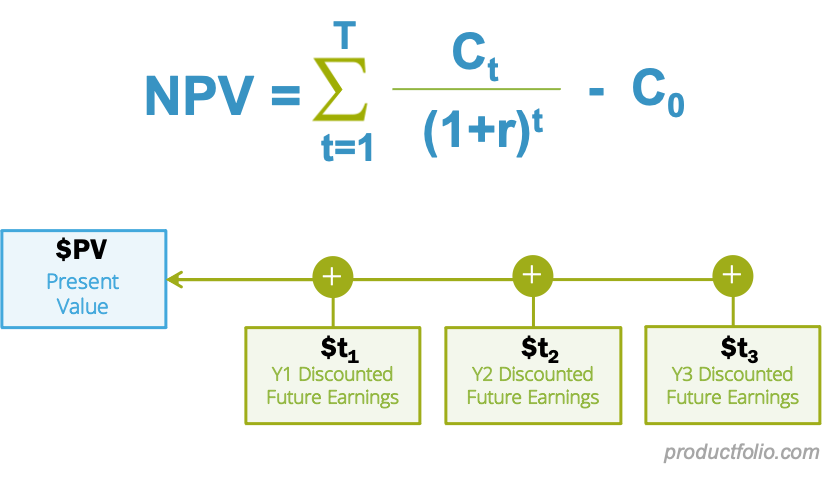What Is Net Present Value (NPV)?
There are many ways or tools available to product managers for prioritizing effectively. It is very rare to find Net Present Value included among these options. This is because it has more to do with Finance than with the core work of a PM. It is, however, worth knowing about due to how useful it can be for evaluating the profitability of projects.

What is Net Present Value?
Net Present Value (NPV) is a method used mainly in financial analysis to determine whether investing in a project is worthwhile. Also sometimes referred to as the net present worth, it seeks to establish what expected future streams of payments or income is worth today.
Investopedia describes it as “the difference between the present value of cash inflows and the present value of cash outflows over a period.” It is commonly used in capital budgeting to establish if the future benefits from a project will justify the investment to be made into such today. You can use it to compare alternative projects to ascertain the best worth pursuing.
The NPV essentially takes into account the time value of money. The money you have today has more value than the same amount promised for later. For example, the $5,000 you have now has more value than the $5,000 you are to receive in a year. This is because you can use that money to make more before the year runs out.
This method involves the use of a discount rate that typically takes into account the cost of capital.
Why NPV May Matter for a PM
As already stated, this concept has more to do with the field of Finance. It may also seem too complex for what product managers can use for feature or product prioritization – its still good to know bout however, since your up-stream Business partners often do use something more sophisticated like NPV for large-scale portfolio investment analysis.
Good knowledge of NPV and financial analysis can help you to better think through the viability of your product or project ideas. This may be useful for more accurately assessing associated potentials. You could find this knowledge beneficial for articulating an opportunity or idea convincingly to stakeholders. It helps you to communicate more effectively the assumptions underlying whatever you are proposing.
How is Net Present Value Calculated?
If you have already projected future cash flows from a project, the NPV helps you to figure what those will amount to today. It shows you the maximum amount that is worth investing today to achieve those projections. The process involves the discounting of expected cash flows to establish their present value. You add together the present values of all anticipated earnings and subtract the estimated costs or investment from the total.
You can calculate the present value of future cash flows using the formula below:
PV = FV/(1+r)n
PV represents the present value, FV is the future value (or anticipated earnings), r is the discount rate, and n is the number of years.
The discount rate in many cases is linked to the cost of capital, which may be borrowings or equity.
In some instances, this rate is what you could have earned if you had used your funds for an alternative investment. This means the rate could be 10%, for example, if that’s what you would have made by putting available money into something else.
Let’s assume a project costing $1,000,000 that will generate a cash flow of $400,000 each year for five years, with the discount rate being 10%. The discounted cash flows will be as follow:
- Year 1 = 400000/(1+0.1) = 363636.36
- Year 2 = 400000/(1+0.1)2 = 330578.51
- Year 3 = 400000/(1+0.1)3 = 300525.92
- Year 4 = 400000/(1+0.1)4 = 273205.38
- Year 5 = 400000/(1+0.1)5 = 248368.53
When these cash flows are summed together, you get approximately $1,516,315 after five years. The Net Present Value will, therefore, be:
$1,516,315 – $1,000,000 = $516,315
There is a function in Excel that simplifies this calculation.
Projects with a higher net present value are more worthy of investment.
What is a Good NPV?
The Net Present Value can be positive or negative when you are done calculating it. A positive NPV indicates that the earnings expected from a project outweigh the costs that will be involved in it. The reverse is the case with a negative reading: anticipated costs exceed anticipated earnings.
Theoretically, an NPV that is greater than zero is good, even it is just $1. The rule is to accept any project that has a positive NPV because it means there’s no net loss. What constitutes a good NPV in many cases, however, is determined by investors or top executives. A positive reading isn’t just enough. There are often higher thresholds – for example, at least $10,000 – for the NPV.
NPV and IRR
Net Present Value is linked to another concept in financial analysis called the Internal Rate of Return (IRR). Experts use this method to calculate the rate of return on investment. IRR, more specifically, aims to determine the interest or discount rate that would make the value of the NPV to be zero. Businesses use it to determine the minimum rate of return that prevents a loss based on current monetary value. The higher the IRR, the more attractive an investment becomes.


